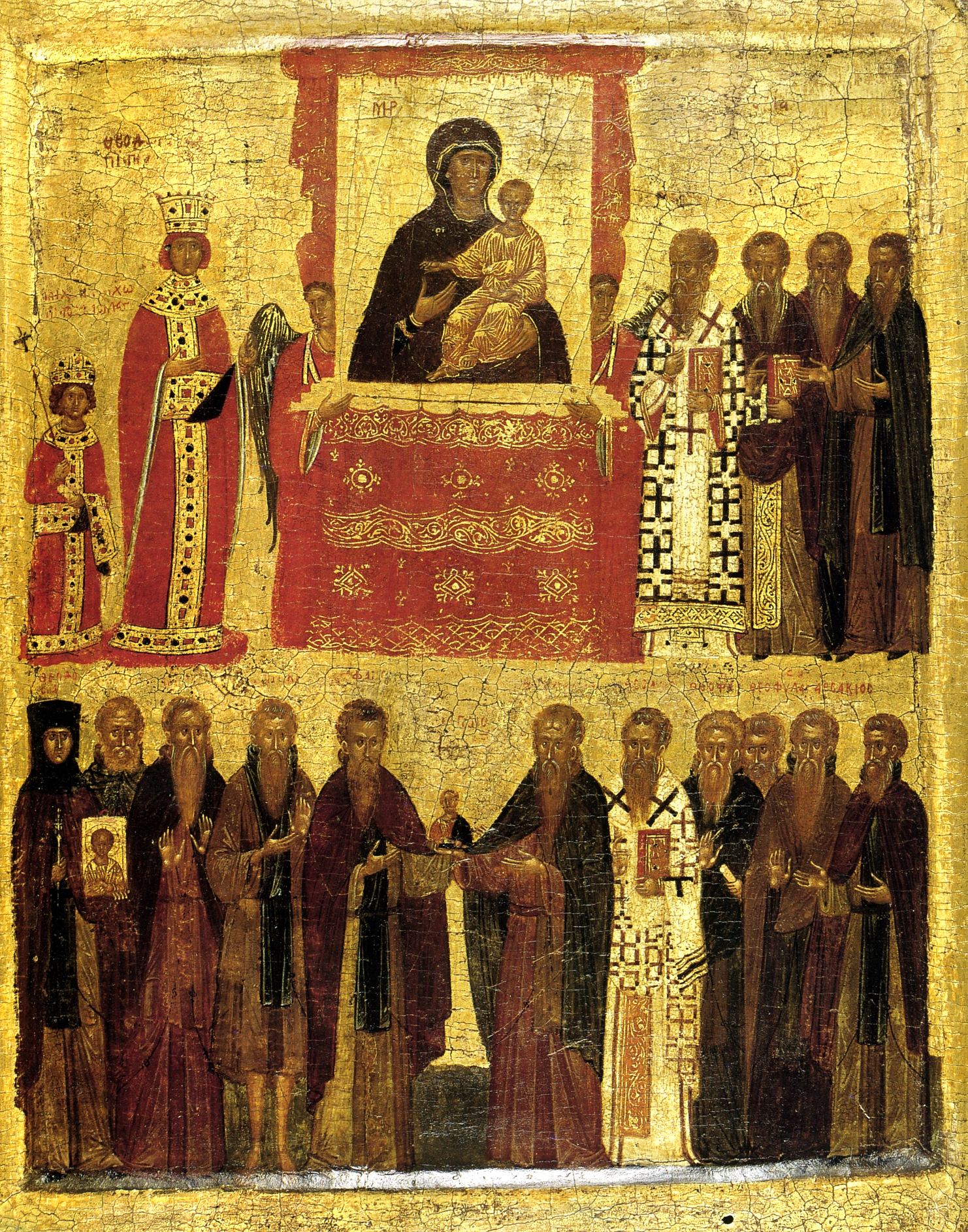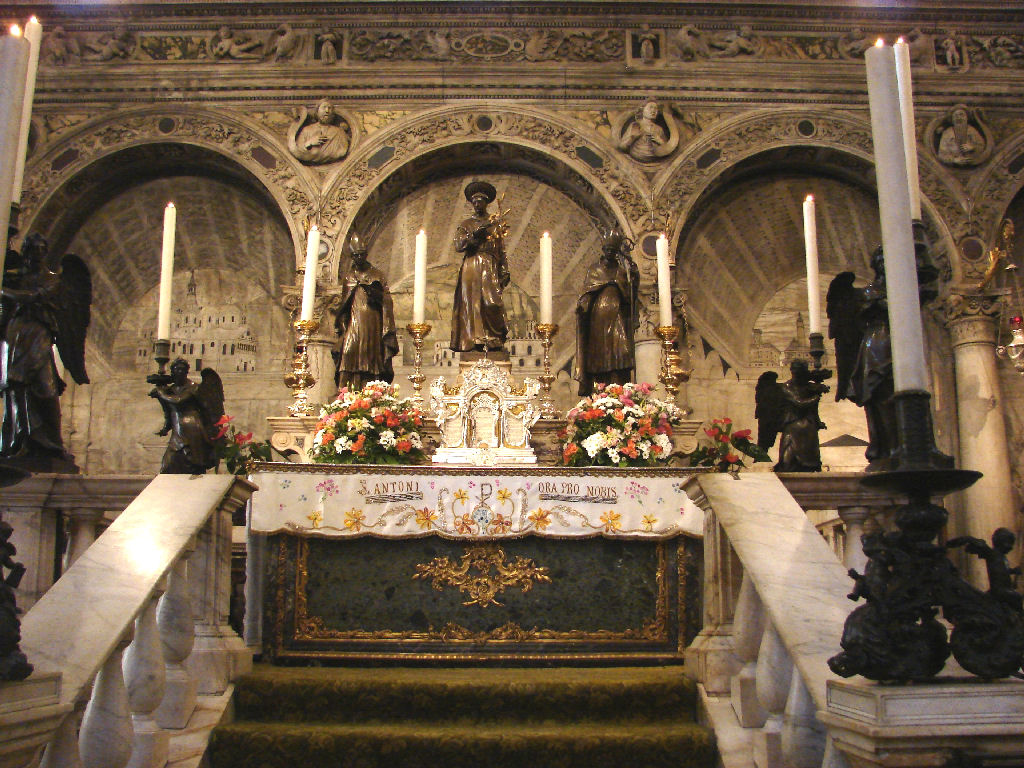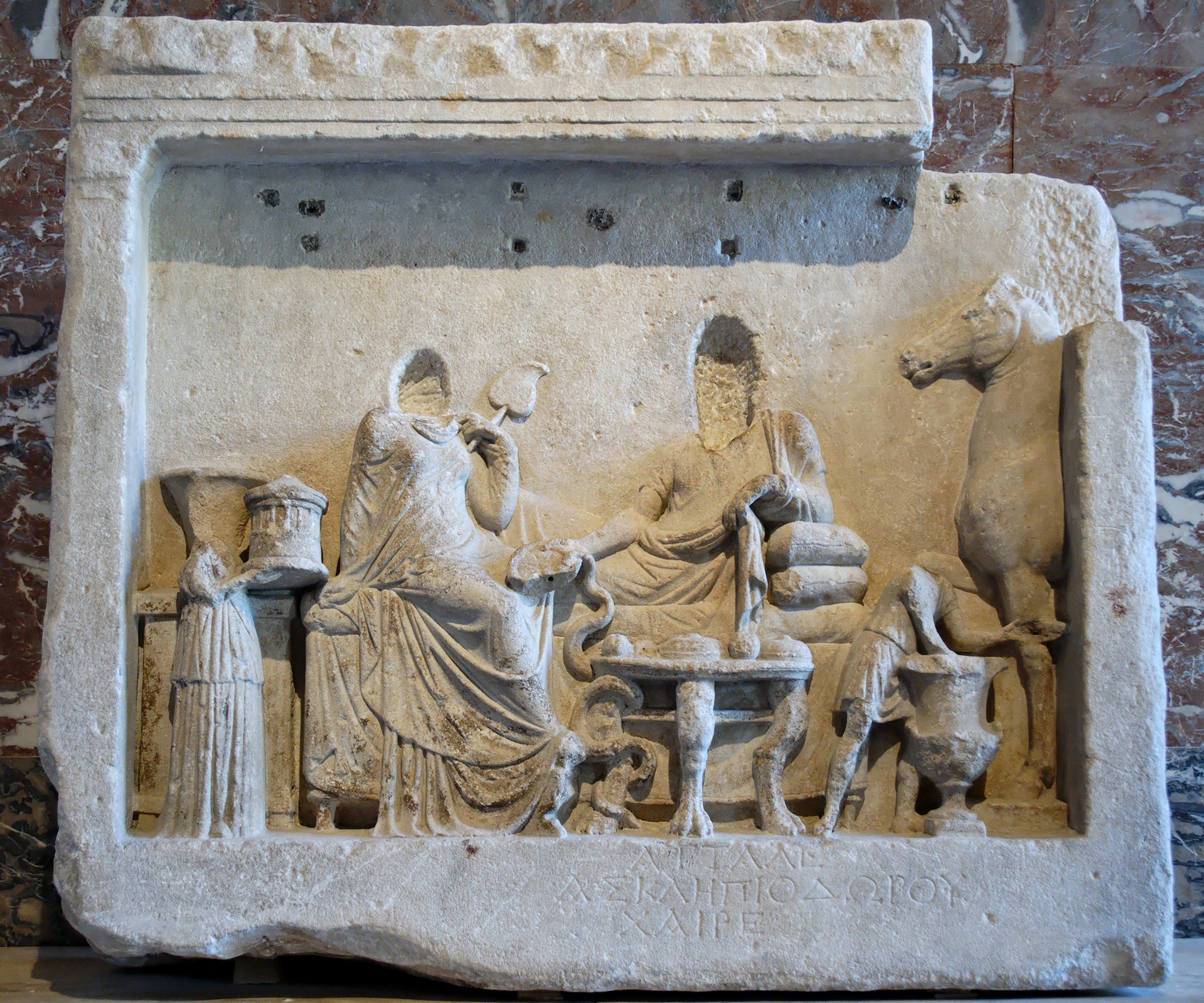|
Theophanes The Confessor
Theophanes the Confessor (; 759 – 817 or 818) was a member of the Byzantine aristocracy who became a monk and chronicler. He served in the court of Emperor Leo IV the Khazar before taking up the religious life. Theophanes attended the Second Council of Nicaea in 787 and resisted the iconoclasm of Leo V the Armenian, for which he was imprisoned. He died shortly after his release. Theophanes the Confessor, venerated on 12 March in both the Eastern Orthodox Church and the Roman Catholic Church, should not be confused with Theophanes of Nicaea, whose feast is commemorated on 11 October. Biography Theophanes was born in Constantinople of wealthy and noble iconodule parents: Isaac, governor of the islands of the Aegean Sea, and Theodora, of whose family nothing is known. His father died when Theophanes was three years old, and the Byzantine Emperor Constantine V (740–775) subsequently saw to the boy's education and upbringing at the imperial court. Theophanes would hold several ... [...More Info...] [...Related Items...] OR: [Wikipedia] [Google] [Baidu] |
Saint
In Christianity, Christian belief, a saint is a person who is recognized as having an exceptional degree of sanctification in Christianity, holiness, imitation of God, likeness, or closeness to God in Christianity, God. However, the use of the term ''saint'' depends on the context and Christian denomination, denomination. In Anglican Communion, Anglican, Oriental Orthodox, and Lutheranism, Lutheran doctrine, all of their faithful deceased in Heaven are considered to be saints, but a selected few are considered worthy of greater honor or emulation. Official Ecclesiastical polity, ecclesiastical recognition, and veneration, is conferred on some denominational saints through the process of canonization in the Catholic Church or glorification in the Eastern Orthodox Church after their approval. In many Protestant denominations, and following from Pauline usage, ''saint'' refers broadly to any holy Christian, without special recognition or selection. While the English word ''saint'' ... [...More Info...] [...Related Items...] OR: [Wikipedia] [Google] [Baidu] |
George Syncellus
George Syncellus (, ''Georgios Synkellos''; died after 810) was a Byzantine chronicler and ecclesiastical official. He lived many years in Palestine (probably in the Old Lavra of Saint Chariton or Souka, near Tekoa) as a monk, before coming to Constantinople, where he was appointed '' synkellos'' (literally, "cell-mate") to Tarasius, patriarch of Constantinople. He later retired to a monastery to write what was intended to be his great work, a chronicle of world history, ''Ekloge chronographias'' (), or ''Extract of Chronography''. According to Anastasius Bibliothecarius, George "struggled valiantly against heresy Iconoclasm.html" ;"title=".e. Iconoclasm">.e. Iconoclasmand received many punishments from the rulers who raged against the rites of the Church", although the accuracy of the claim is suspect. As a '' synkellos'', George stood high in the ecclesiastical establishment of Constantinople. The position carried no defined duties, but the incumbent would generally serve as the ... [...More Info...] [...Related Items...] OR: [Wikipedia] [Google] [Baidu] |
Roman Martyrology
The ''Roman Martyrology'' () is the official martyrology of the Catholic Church. Its use is obligatory in matters regarding the Roman Rite liturgy, but dioceses, countries and religious institutes may add duly approved appendices to it. It provides an extensive but not exhaustive list of the saints recognized by the Church. History In 1582, Pope Gregory XIII decreed a revision of the Julian calendar, creating a new system, now called, after him, the Gregorian calendar. The ''Roman Martyrology'' was first published in 1583. A second edition was published in the same year. The third edition, in 1584, was made obligatory wherever the Roman Rite was in use. The main source was the Martyrology of Usuard, completed by the ''Dialogues'' of Pope Gregory I and the works of some of the Fathers, and for the Greek saints by the catalogue known as the Menologion of Sirlet. Its origins can be traced back to the Martyrologium Hieronymianum, which was originally based on calendars of Roman, A ... [...More Info...] [...Related Items...] OR: [Wikipedia] [Google] [Baidu] |
Iconoclasm
Iconoclasm ()From . ''Iconoclasm'' may also be considered as a back-formation from ''iconoclast'' (Greek: εἰκοκλάστης). The corresponding Greek word for iconoclasm is εἰκονοκλασία, ''eikonoklasia''. is the social belief in the importance of the destruction of icons and other images or monuments, most frequently for religious or political reasons. People who engage in or support iconoclasm are called iconoclasts, a term that has come to be figuratively applied to any individual who challenges "cherished beliefs or venerated institutions on the grounds that they are erroneous or pernicious." Conversely, one who reveres or venerates religious images is called (by iconoclasts) an ''Iconolatry, iconolater''; in a Byzantine context, such a person is called an ''iconodule'' or ''iconophile.'' Iconoclasm does not generally encompass the destruction of the images of a specific ruler after their death or overthrow, a practice better known as ''damnatio memoriae'' ... [...More Info...] [...Related Items...] OR: [Wikipedia] [Google] [Baidu] |
Theophanes The Confessor Bids Farewell To Patriarch Nikephoros
Theophanes may refer to: Saints *Theodorus and Theophanes (ca. 778-845), called the Grapti, proponents of the veneration of images during the second Iconoclastic controversy *Theophanes the Confessor Byzantine 8th-9th-century historian *Theophan the Recluse (1815–1894) Russian saint *Théophane Vénard (1821-1869) one of the Vietnamese Martyrs Others *Theophanes of Mytilene (1st century BC) political figure and historian in Lesbos *Theophanes of Byzantium (6th century) Byzantine historian * Theophanes the Branded (also called Theophanes Graptus or Theophanes of Nicea, 775-845), Byzantine monk and hymnographer *Theophanes Continuatus Latin name applied to a chronicle continuing the history of Theophanes the Confessor * Theophanes (chamberlain) (''fl.''c. 920-945) Byzantine official and chief minister of Emperor Romanos Lekapenos * Theophanes Nonnus (''fl.''c. 950), Byzantine physician who wrote outline of medicine dedicated to Emperor Constantine VII Porphyrogenitus * Theophanes ... [...More Info...] [...Related Items...] OR: [Wikipedia] [Google] [Baidu] |
Icon
An icon () is a religious work of art, most commonly a painting, in the cultures of the Eastern Orthodox, Oriental Orthodox, Catholic Church, Catholic, and Lutheranism, Lutheran churches. The most common subjects include Jesus, Mary, mother of Jesus, Mary, saints, and angels. Although especially associated with portrait-style images concentrating on one or two main figures, the term also covers most of the religious images in a variety of artistic media produced by Eastern Christianity, including narrative scenes, usually from the Bible or the lives of saints. Icons are most commonly painted on wood panels with egg tempera, but they may also be cast in metal or carved in stone or embroidered on cloth or done in mosaic or fresco work or printed on paper or metal, etc. Comparable images from Western Christianity may be classified as "icons", although "iconic" may also be used to describe the static style of a devotional image. In the Greek language, the term for icon painting uses ... [...More Info...] [...Related Items...] OR: [Wikipedia] [Google] [Baidu] |
Veneration
Veneration (; ), or veneration of saints, is the act of honoring a saint, a person who has been identified as having a high degree of sanctity or holiness. Angels are shown similar veneration in many religions. Veneration of saints is practiced, formally or informally, by adherents of some branches of all major religions, including Christianity, Judaism,"Veneration of saints is a universal phenomenon. All monotheistic and polytheistic creeds contain something of its religious dimension... " Hinduism, Islam, Buddhism and Jainism. Within Christianity, veneration is practiced by groups such as the Catholic Church, Eastern Orthodox Church, and the Oriental Orthodox Church, all of which have varying types of canonization or glorification processes. In Catholicism and Orthodoxy, veneration is shown outwardly by respectfully kissing, bowing or making the sign of the cross before a saint's icon, relics, or statue, or by going on pilgrimage to sites associated with saints. The Lutheranis ... [...More Info...] [...Related Items...] OR: [Wikipedia] [Google] [Baidu] |
Abbot
Abbot is an ecclesiastical title given to the head of an independent monastery for men in various Western Christian traditions. The name is derived from ''abba'', the Aramaic form of the Hebrew ''ab'', and means "father". The female equivalent is abbess. Origins The title had its origin in the monasteries of Egypt and Syria, spread through the eastern Mediterranean, and soon became accepted generally in all languages as the designation of the head of a monastery. The word is derived from the Aramaic ' meaning "father" or ', meaning "my father" (it still has this meaning in contemporary Arabic: أب, Hebrew: אבא and Aramaic: ܐܒܐ) In the Septuagint, it was written as "abbas". At first it was employed as a respectful title for any monk, but it was soon restricted by canon law to certain priestly superiors. At times it was applied to various priests, e.g. at the court of the Frankish monarchy the ' ("of the palace"') and ' ("of the camp") were chaplains to the Merovingian ... [...More Info...] [...Related Items...] OR: [Wikipedia] [Google] [Baidu] |
Kalymnos
Kalymnos (; ) is a Greek island and municipality in the southeastern Aegean Sea. It belongs to the Dodecanese island chain, between the islands of Kos (south, at a distance of ) and Leros (north, at a distance of less than ): the latter is linked to it through a series of islets. Kalymnos lies between two and five hours away by sea from the island of Rhodes. In 2021 the island had a population of 17,752, making it the third most populous island of the Dodecanese, after Kos and Rhodes. It is known in Greece for the affluence of much of its population, and also stands as both the wealthiest member of the Dodecanese and one of the wealthiest Greek islands overall. The Municipality of Kalymnos, which includes the populated offshore islands of Pserimos, Telendos, Kalolimnos, and Pláti, as well as several uninhabited islets, has a combined land area of and a total population of 17,752 inhabitants (2021). Naming The island is known as ''Càlino'' in Italian and ''Kilimli'' or '' ... [...More Info...] [...Related Items...] OR: [Wikipedia] [Google] [Baidu] |
Sea Of Marmara
The Sea of Marmara, also known as the Sea of Marmora or the Marmara Sea, is a small inland sea entirely within the borders of Turkey. It links the Black Sea and the Aegean Sea via the Bosporus and Dardanelles straits, separating Turkey's European and Asian sides. It has an area of , and its dimensions are . Its greatest depth is . Name The Sea of Marmara is named after the largest island on its south side, called Marmara Island because it is rich in marble ( Greek , ''mármaron'' 'marble'). In classical antiquity, it was known as the Propontis, from the Greek words ''pro'' 'before' and ''pontos'' 'sea', reflecting the fact that the Ancient Greeks used to sail through it to reach the Black Sea, which they called ''Pontos''. Mythology In Greek mythology, a storm on the Propontis brought the Argonauts back to an island they had left, precipitating a battle in which either Jason or Heracles killed King Cyzicus, who had mistaken them for his Pelasgian enemies. Geography ... [...More Info...] [...Related Items...] OR: [Wikipedia] [Google] [Baidu] |
Cyzicus
Cyzicus ( ; ; ) was an ancient Greek town in Mysia in Anatolia in the current Balıkesir Province of Turkey. It was located on the shoreward side of the present Kapıdağ Peninsula (the classical Arctonnesus), a tombolo which is said to have originally been an island in the Sea of Marmara only to be connected to the mainland in historic times either by artificial means or an earthquake. The site of Cyzicus, located on the Erdek and Bandırma roads, is protected by Turkey's Turkish Ministry of Culture, Ministry of Culture. History Ancient The city was said to have been founded by Pelasgians from Thessaly, according to tradition at the coming of the Argonauts; later it received many colonies from Miletus, allegedly in 756 BC, but its importance began near the end of the Peloponnesian War when the conflict centered on the sea routes connecting Greece to the Black Sea. At this time, the cities of Athens and Miletus diminished in importance while Cyzicus began to prosper. Co ... [...More Info...] [...Related Items...] OR: [Wikipedia] [Google] [Baidu] |





